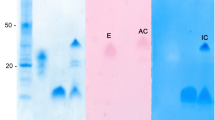Abstract
A protease of a molecular mass of approximately 30 kDa was isolated and purified from the haloalkaliphilic archaeon Natronomonas (formerly Natronobacterium) pharaonis. The enzyme hydrolyzed synthetic peptides, preferentially at the carboxyl terminus of phenylalanine or leucine, as well as large proteins. Hydrolysis occurred over the range of pH from 6 to 12, with an optimum at pH 10. The temperature optimum was 61°C. The enzyme was nearly equally active over the range of salt concentration from 0.5 to 4 M (NaCl or KCl). A strong cross-reaction with a polyclonal antiserum against human chymotrypsin was observed. Enzymatic activity was inhibited by typical serine protease inhibitors. There was significant homology between N-terminal and internal sequences from autolytic fragments and the sequence of bovine chymotrypsinogen B; the overall amino acid composition was similar to that of vertebrate chymotrypsinogens. Evidence for a zymogen-like processing of the protease was obtained. Cell extracts from other halobacteria exhibited similar proteolytic activity and immunoreactivity. The data suggested a widespread distribution of a chymotrypsinogen B-like protease among halo- and haloalkaliphilic Archaea.
Similar content being viewed by others
Author information
Authors and Affiliations
Additional information
Received: September 12, 1998 / Accepted: December 15, 1998
Rights and permissions
About this article
Cite this article
Stan-Lotter, H., Doppler, E., Jarosch, M. et al. Isolation of a chymotrypsinogen B-like enzyme from the archaeon Natronomonas pharaonis and other halobacteria. Extremophiles 3, 153–161 (1999). https://doi.org/10.1007/s007920050111
Issue Date:
DOI: https://doi.org/10.1007/s007920050111




